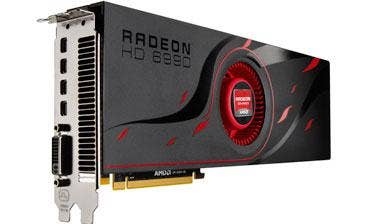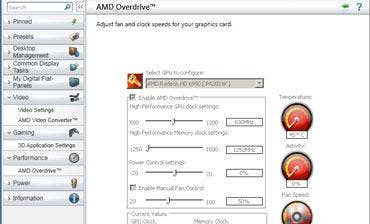Review: Radeon HD 6990 Graphics Card Doubles Specs

In a world of 96-core servers, it takes a lot to wow us. And 3,072 stream processors comes close. That's what's inside the Radeon HD 6990, the latest video card from AMD that's known in some circles as "the best video card you can buy."
And it ought to be. With not just one, but two DirectX 11-capable GPUs, 4 GB of dedicated GDDR5 memory, 64 dedicated color raster operators (ROPs), another 256 z/Stencil ROPs (for shadowing) and an 830-MHz clock speed, this board would win the prize for the most densely-packed video card available, if such a prize existed.
If you're familiar with the Radeon 6970, the 6990 doubles that spec. In fact, the board even has two BIOSes, permitting power-hungry users to toggle between a standard (factory-supported) BIOS of 375 watts of thermal design power (TDP) and 450 watts TDP and higher clock speeds.
For all those video-game tweakers out there, it even lets you crank up the core speed to 880 MHz. A dedicated video playback accelerator keeps the MPEG and Flash video action fast and furious, and support for dual-stream 1080p playback and HD3D, Blu-ray 3D and active shutter technology are just the beginning of its full immersion capability.
What's all that hardware doing? For one thing, it's slinging pixels and texture maps around at speeds of up to 320 GBps, and at resolutions up to 2560 x 1600. At that resolution, we were able to get a sustained rate of 60 frames per per second when running DIRT 3, the latest version of a driving game from Codemasters Software.
Specs And More Specs

The frame rate jumped to 90 fps at 1920 x 1080. For these tests, we set the multi-sample anti-aliasing (MSAA) to 4x and vertical sync was off. Testing was done on an Asus Crosshair IV motherboard with a six-core AMD Phenom II X6 processor, 4 GB DDR 3 memory in a two-channel configuration running 64-bit Windows 7 Ultimate N. Frame rate was measured using Fraps 3.2.2 from Beepa Pty Ltd.
Like most video boards of this caliber, the Radeon HD 6990 requires a pair of extra PCI PEG eight-pin power connectors and it occupies a PCIe x16 and two card slots at the PC's rear, one for its five outputs (four HDMI, one DVI-D) and another for heat exhaust (which topped out at 94 degrees after 24 hours of continuous use). Of course, the 9660 is compatible with AMD's Eyefinity technology for connecting as many as five displays as if they were one.
Included with all Radeon graphics controllers is AMD's Vision Engine Control Center, which provides control over all of the board's settings for performance and user preferences. Among them is AMD Overdrive (shown), which by default sets clock speed at 830MHz and memory at 1250 MHz. The AMD control panel, which can be launched by right-clicking the desktop, also provides control over video settings such as edge enhancement, flesh tone correction and mosquito noise reduction, the latter of which is great for keeping things comfortable during those hot sticky nights in trenches.
The Radeon HD 6990 is priced on the high side at $699, and can even be found selling for more on the street. When state-of-the-art video control is called for, the Radeon HD 6990 is the recommended product by the CRN Test Center.